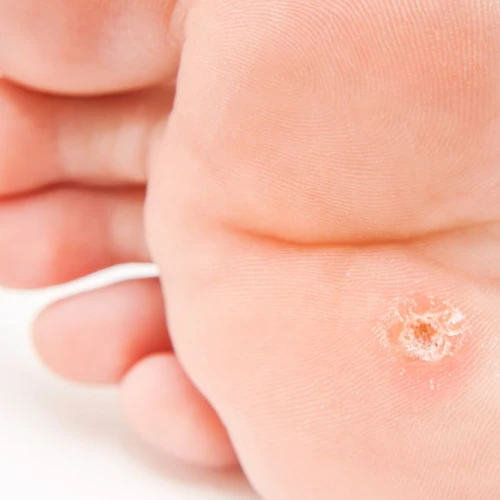What is a callus? And How do you treat it?1, 2
Calluses are layers of dead skin, also described as hardened skin, which form over an area of rubbing. They usually occur on the bottom on the foot but can also be found just behind the toes, an area where the bones come into contact with the ground. Calluses can also develop on the hands or other areas of the body subject to repeated trauma.
How do I know if I have a callus?
The characteristic feature of a callus (which has a crumbly texture and is yellow coloured) is a small area of hardened skin. If you notice this type of lesion on your toes, arch of your foot or heel, it's probably a callus.
What is the difference between a callus and a corn on your foot?1, 2
A callus is a medium-sized area of flat and hardened skin. A corn, however, is a small (pea-sized or slightly larger) round, hardened and well-defined area that mostly penetrates into the underlying dermis. A spike in the centre of the corn enters into the foot. A callus has no central plug and has a more even appearance than a corn.
Also, corns and calluses do not occur in the same places. Calluses usually develop on the arch of the foot while corns are found on the tops of toes, on the outside of the little toe or between two toes.
Finally, corns are more painful that calluses as they penetrate more deeply into the skin.
How do calluses form on the feet?2
Corns, hardened skin and calluses are caused by repeated rubbing of footwear and/or excessive compression of the skin against a bony prominence on the foot when walking. These two factors encourage hyperkeratosis, i.e. the thickening of the upper layer of the epidermis, by stimulating keratin (a protein found in the epidermis) production.
How do you get rid of a callus?3
You can treat a callus on your foot at home by following a few simple steps.
Remove excess skin with a pumice
Use a pumice stone, file or emery paper to gently remove the thickened skin. This will gradually remove the excess layer of skin. The best way to remove excess skin is to soften the area by soaking your feet in warm water for 20 minutes and regularly applying moisturising cream.
Use corn-removal products
You can use corn-removal products to remove the callus. These products contain salicylic acid which dissolves keratin, softens the stratum corneum and makes it drop off. These products are available in the form of ointments, pastes or plasters. Only apply the product to the area of the callus, as it can also destroy healthy skin, causing an injury. After applying the corn-removal product, cover the treated area with a protective dressing.
These over-the-counter products are available from chemists and can be used by most people. However, diabetics, people with peripheral arterial disease affecting the lower limbs or people suffering from a skin condition affecting their feet (eczema, psoriasis, etc.) should not use them.
If you are diabetic and have a callus, don't try to treat it yourself at home, make an appointment with a pedicurist/podiatrist. People with diabetes have an increased risk of injury or infection caused by irritation after using a pumice stone on the skin, but there is also an increased risk of poor healing after using a corn-removal product.
Wear suitable footwear
If you have a callus on your foot, wear light and soft shoes that are wide enough to prevent repeated rubbing. When you put them on, make sure there is enough room between your foot and the footwear, and above your toes. Choose shoes with a good sole and low heel (3-4 cm).
Take care of your feet
Use moisturising cream every day to limit dry skin, which is a risk factor for hard skin, corns and calluses.
When should you seek medical advice?3
Calluses are benign lesions and in most cases they disappear with home care. However, it is best to consult a doctor or pedicurist/podiatrist if:
- The area becomes red and painful;
- The discomfort when walking is so intense it stops you doing some of your usual activities;
- You have fallen due to the callus on your foot;
- You are diabetic or have peripheral arterial disease affecting your lower limbs;
- You have a skin condition affecting your feet.
Treatment of calluses by a pedicurist/podiatrist4
If necessary, your doctor can prescribe pedicurist/podiatrist care to remove the callus/calluses. The pedicurist/podiatrist will remove the callus with a sharp and/or rotary instrument. This type of action gradually reduces the volume of the corn. The intervention of a pedicurist/podiatrist helps alleviate pain when walking by reducing the pressure exerted on foot tissues. It may take several sessions to completely remove the callus.
If the pedicurist/podiatrist believes the callus was caused by pressure exerted on your foot, they can recommend you wear customised orthopaedic inserts.
Regular care from a pedicurist/podiatrist may be necessary in patients who are prone to painful and stubborn calluses.
What should you do if you have an infection?4
If a corn or a callus becomes infected, general practitioners can prescribe disinfectant treatment and, if necessary, nursing care delivered by a pedicurist/podiatrist.
Finally, when calluses are caused by a deformity of the toes or foot, your general practitioner may recommend that you:
- Wear orthopaedic inserts;
- Wear orthopaedic shoes;
- Have orthopaedic surgery to correct a major deformity (e.g. hallux valgus surgery).
How to prevent hard skin, corns and calluses?5
Wear suitable footwear
The best way to prevent these benign foot problems is primarily to wear soft shoes fitted to the shape of your foot. This will prevent repeated rubbing and excessive compression from the shoe on the tops of your feet.
Good foot hygiene
Good foot hygiene can also reduce the risk of having corns, hard skin and calluses:
- Regularly check the condition of your feet to identify the early signs of any problem such as redness, thickening of the skin, initial signs of deformity, etc. The earlier these signs are detected, the easier it will be to treat them.
- Wash your feet every day with soap; do not forget about the gaps between your toes.
- If you have dry skin, use a moisturising cream to prevent hyperkeratosis.
Special recommendations for people at risk
A foot examination performed by a doctor is recommended for people aged over 75 and for diabetics.
The elderly may find it harder to look after their feet by themselves, putting them at a greater risk of having foot injuries and therefore falls. They may be referred to a pedicurist/podiatrist.
Diabetics should be particularly aware of the health of their feet, as they have a greater risk of having lesions and infections. For some patients in France, medical insurance covers several sessions each year with a podiatrist, subject to a medical prescription.


